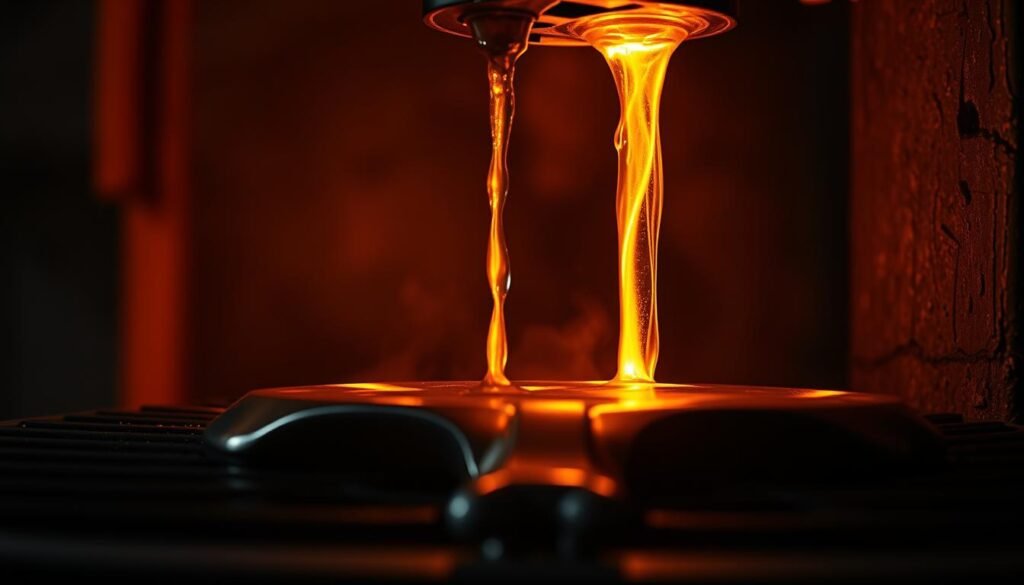Stainless steel is a versatile alloy primarily composed of iron and chromium, with additions of nickel and other elements. It’s prized for its exceptional corrosion resistance and durability.
The melting point of stainless steel is not a fixed value but rather a range, typically between 1,370 to 1,530 degrees Celsius (2,500 to 2,800 degrees Fahrenheit). This variation is due to the different grades and proportions of metals used in the alloy.
Understanding the melting temperature of steel is crucial for engineers, manufacturers, and anyone working with this versatile material in high-temperature environments. This article will explore the factors that affect the melting point of stainless steel and its practical implications.
Understanding Melting Points in Materials
Understanding the melting behavior of materials is essential in various industrial applications. The melting point of a material is a critical property that determines its suitability for different uses.
The Science Behind Melting Points
The melting point is the temperature at which a material changes state from solid to liquid. For pure metals, this transition occurs at a precise temperature due to their uniform atomic structure.
How Melting Points Differ Between Pure Metals and Alloys
In contrast to pure metals, alloys like steel exhibit a melting range rather than a single melting point. This is because alloys contain multiple elements with different melting characteristics, leading to a phenomenon known as “melting point depression.” The addition of elements such as carbon, chromium, and nickel in steel lowers its overall melting point and creates a range between the solidus and liquidus temperatures.
Key differences between pure metals and alloys include:
- Pure metals have a distinct melting point, while alloys have a melting range.
- The introduction of different elements in alloys disrupts their crystalline structure, affecting their melting behavior.
- Understanding these differences is crucial for processes like casting, welding, and heat treatment.
What Temp Does Stainless Steel Melt: The Complete Answer
The temperature at which stainless steel melts is not a single point, but rather a range. This characteristic is crucial for various industrial applications, including welding and casting.
The Temperature Range for Stainless Steel Melting
Stainless steel melts between 2500-2800°F (1371-1540°C). This range is due to the alloy’s complex composition, which includes iron, chromium, nickel, and carbon. The presence of these elements, particularly chromium and nickel, affects the melting behavior of stainless steel.
The specific melting range can vary depending on the grade of stainless steel. Different formulations contain varying proportions of alloying elements, which influence the melting characteristics.

| Stainless Steel Grade | Melting Range (°F) | Melting Range (°C) |
|---|---|---|
| Austenitic | 2500-2750 | 1371-1510 |
| Ferritic | 2700-2800 | 1482-1540 |
| Martensitic | 2600-2800 | 1427-1538 |
Why Stainless Steel Has a Melting Range Rather Than a Fixed Point
Stainless steel exhibits a melting range rather than a fixed melting point because it is a complex alloy containing multiple elements. Each of these elements has its own melting characteristics, which interact to create a material that transitions gradually from a solid to a liquid state across a temperature range.
This phenomenon, known as the “melting range” in metallurgy, is characteristic of most metal alloys. During heating, stainless steel begins to soften at its solidus temperature and becomes completely liquid at its liquidus temperature. Understanding this characteristic is essential for engineers and manufacturers to avoid issues during high-temperature processing.
Factors Affecting the Melting Point of Stainless Steel
Understanding the factors that affect the melting point of stainless steel is essential for various industrial applications. The melting behavior of stainless steel is not solely determined by its inherent properties but is also influenced by external and internal factors.
Chemical Composition and Its Impact
The chemical composition of stainless steel plays a significant role in determining its melting point. Different alloying elements, such as chromium, nickel, and molybdenum, can alter the melting behavior. For instance, the addition of certain elements can lower or raise the melting point. The precise control of chemical composition is crucial for achieving the desired melting characteristics.
Crystal Structure Influence
The crystal structure of stainless steel also influences its melting point. Different crystal structures, such as austenitic, ferritic, or martensitic, exhibit varying melting behaviors. The arrangement of atoms within the crystal lattice affects the thermal properties of the material. Understanding the crystal structure is vital for predicting the melting behavior.
External Factors: Pressure and Atmosphere
External factors, including pressure and atmosphere, can significantly impact the melting point of stainless steel. Increased pressure can raise the melting point, while certain gases or contaminants in the atmosphere may influence the alloy’s behavior at high temperatures.
| External Factor | Effect on Melting Point | Industrial Implication |
|---|---|---|
| Increased Pressure | Raises Melting Point | Affects processing conditions |
| Atmospheric Composition | Can alter melting behavior | Influences surface properties |
| Contaminants or Fluxes | Localized changes in melting temperature | Impacts material integrity |
Melting Points Across Different Stainless Steel Grades
The melting behavior of stainless steel varies significantly across different grades, each with its unique composition and microstructure. This variability is crucial for engineers and manufacturers to understand, as it directly impacts the performance and application of stainless steel in various industries.
Austenitic Stainless Steel (304, 316) Melting Points
Austenitic stainless steel grades, such as 304 and 316, are widely used due to their excellent corrosion resistance and formability. The melting points of these grades typically range from 1,375°C to 1,450°C. For instance, grade 304 has a melting point between 1,400-1,450°C, while grade 316 melts between 1,375-1,400°C. The subtle variations in melting points within this category are primarily due to differences in their alloying elements.
Ferritic and Martensitic Stainless Steel Melting Points
Ferritic and martensitic stainless steel grades exhibit different melting behaviors compared to austenitic grades. Ferritic grades, like 430, have higher melting points, typically ranging from 1,425°C to 1,510°C. Martensitic grades also have distinct melting characteristics, influenced by their higher carbon content and different alloying elements. The higher melting points of ferritic grades make them suitable for applications requiring high-temperature resistance.
Comparative Analysis of Common Grades
A comparative analysis of common stainless steel grades reveals distinct patterns in their melting points, correlating with their composition and microstructure. The table below summarizes the melting points of various stainless steel grades:
| Grade | EN Specification | Melting Point (°C) |
|---|---|---|
| 304 | 1.4301 | 1400-1450 |
| 316 | 1.4401 | 1375-1400 |
| 430 | 1.4016 | 1425-1510 |
| 310 | 1.4845 | 1400-1450 |
The differences in melting points among various grades, though sometimes small, can significantly impact their performance in high-temperature applications. Understanding these differences is crucial for selecting the optimal grade for specific temperature requirements while balancing other factors like corrosion resistance, strength, and cost.
Methods for Determining Stainless Steel Melting Points
Understanding the melting behavior of stainless steel requires precise laboratory measurements. Various techniques are employed to determine the melting point of stainless steel, each offering unique insights into its thermal properties.
Laboratory Techniques and Equipment
Laboratory techniques play a crucial role in determining the melting point of stainless steel. Traditional methods involve using thermocouples and pyrometry to measure temperature changes.
- Thermocouples measure temperature changes directly.
- Pyrometry uses non-contact infrared devices for temperature measurement.
Differential Scanning Calorimetry and Other Modern Methods
Modern techniques have revolutionized the determination of melting points. Differential Scanning Calorimetry (DSC) is a prominent method that measures heat flow into or out of a sample as it is heated.
- DSC provides a distinct peak indicating the melting temperature.
- Other methods include Thermogravimetric Analysis (TGA) and high-temperature X-ray diffraction.
These advanced techniques offer comprehensive data on the melting behavior of stainless steel, capturing the complete melting profile.
Practical Implications of Stainless Steel’s Melting Point
The temperature at which stainless steel melts has significant implications for its use in different industries. Consequently, the melting point is an important parameter to consider when choosing materials or fabrication techniques for stainless steel. High temperatures affect most metals’ tensile strength, and steel is no exception.

Manufacturing and Processing Considerations
When exposed to extreme heat, steel becomes more rigid and easier to bend. For stainless steel, this usually happens at about 1000°C. Manufacturers must consider these properties when designing processing techniques.
Working with stainless steel at high temperatures requires careful planning to avoid material degradation.
High-Temperature Applications and Limitations
Stainless steel is often used in high-temperature applications due to its heat resistance. However, its strength diminishes significantly well before reaching its melting point.
Understanding these limitations is crucial for ensuring the structural integrity of stainless steel components in extreme environments.
Safety Considerations When Working with Heated Stainless Steel
Working with stainless steel at temperatures approaching its melting point presents significant safety hazards. Molten or near-molten stainless steel can cause catastrophic burns and injuries.
- Appropriate personal protective equipment, including heat-resistant clothing and face shields, is necessary.
- Adequate ventilation systems are required to mitigate the emission of harmful fumes.
- Training and certification for personnel working with high-temperature stainless steel processing are essential.
Conclusion
Understanding the melting point of stainless steel is crucial for its effective use in various high-temperature applications. The melting point, which ranges from 1,370 to 1,530°C, is influenced by the alloy’s composition and crystal structure. Different grades of stainless steel exhibit varying melting behaviors, affecting their suitability for specific industries. This knowledge is vital for manufacturing processes, material selection, and safety considerations. As industrial applications continue to evolve, understanding the melting point and related properties of stainless steel remains essential for engineers and manufacturers.
